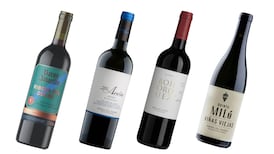I can still remember my first taste of Portuguese wine; it was a 10-year-old red, which I expected to be delicate, light and almost sweet, the way most elderly wines are. Instead, I got a mouthful of incredibly rough, tough, dry, mouth-puckering, teeth-staining, tannic wine. It was a while before I tried another.
Back then, Portugal made wines that were resolutely traditional, in a style that only masochists and apparently, the Portuguese, enjoyed. Every now and again you would come across a real gem and it made you wonder just how good the wines could be.
Today they are a very different proposition, having evolved into a very approachable more modern style whilst thankfully retaining something of their unique personality. Portugal always has been able to grow high-quality grapes; in recent years the standard of winemaking has increased dramatically. Almost uniquely, Portugal has resisted the temptation to plant the well-known international grape varieties, and instead has held on to a rich heritage that marks the wines out as different and fascinating. It should be an unbeatable formula, yet somehow it hasn’t quite happened yet. The range available in Ireland has grown, largely thanks to two intrepid importers, but a real breakthrough still awaits.
It isn’t that we don’t know the country. Apparently more than 500,000 Irish tourists visit Portugal every year, but the vast majority head south to the golf courses and resorts of the Algarve, ignoring the rest of the country.
Those who haven’t travelled north are missing out; in my limited experience, the rest of Portugal has many areas of stunning beauty. In addition, it has Pousados, their version of Paradores – wonderful hotels with real character.
Tourists seeking a change from the Algarve should certainly head up to the jaw-dropping Douro valley, one of the most beautiful wine regions I have ever visited. These days you will find some excellent Portuguese table wines, as well as the renowned Ports. Wine tourism has developed here as in other parts of Portugal.
I featured Portuguese white wines late last year. I am a big fan of the Portuguese Alvarinos, its version of the Spanish Alvariño, from Rías Baixas, which lies just over the border. I would also suggest looking out for white Dão, made principally with the Encruzado grape, or wines from elsewhere made using the Arinto and Antão Vaz varieties.
However, the red wines also deserve far greater attention than they receive in this country. Most wine-drinkers would be hard-pushed to name one Portuguese grape variety, but those in the know would certainly put forward Touriga Nacional as Portugal’s greatest. This grape, now considered the backbone of most Port, as well as being grown throughout the country, was on the verge of extinction in the 1970s. In addition to Port, it is responsible for some of the best long-lived red wines.
You will also find Trincadeira, Tinta Barroca, Tinta Franca, Castelão, Alfrocheiro, Alicante Bouschet, Sousão and many others. Some are superstars in waiting, others merely interesting. All of these are uniquely Portuguese, with the only foreign grape being the Spanish Tempranillo, here known as Tinta Roriz or Aragoñez.
They may be confusing but I will always make time for a country with grape varieties going under the name of ‘fly-droppings’ (Barrado das Mosca) Bastardo, and ‘dog-strangler’ (Esgana Cão).
Most red wines are a blend of several grape varieties, occasionally with a dollop of Cabernet Sauvignon or Syrah.
It is a mistake to see Portugal as a uniformly hot country, producing big powerful red wines. This may be true of some parts, but the long Atlantic coast provides plenty of cooling breezes (and plenty of rain too) that can make for very elegant wines.
Dão, from the north can be almost Pinot-like in its fragrance and elegance. Even in the baking hot Alentejo, home to cork trees and the famous black pig, there are plenty of cooler vineyards at higher altitudes. The area around Lisbon is the latest to get enthusiasts excited.
Portuguese wines certainly don’t lack character. Those who become interested get hooked; aficionados include wine writer Richard Mayson, who has “gone native” with a vineyard in the Alentejo. His excellent wines can be found in Terroirs in Donnybrook.
For those travelling to Portugal this summer, I would recommend a little exploration. The rest of us can enjoy wines such as those below.












